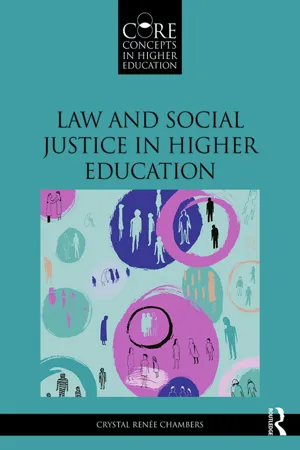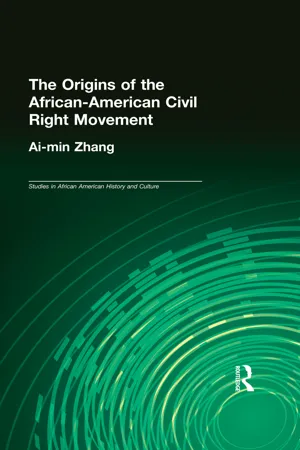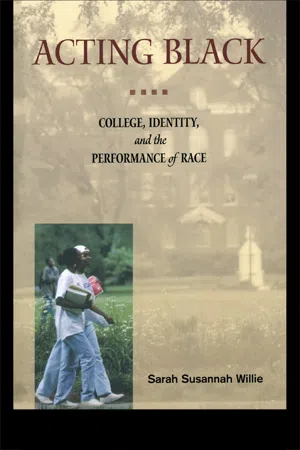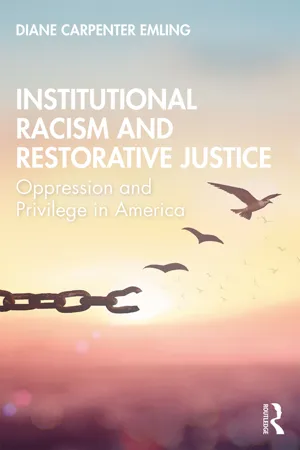Black Codes
Black Codes were laws enacted in the southern United States during the Reconstruction era to restrict the freedom and rights of African Americans. These laws aimed to maintain white supremacy by regulating the labor, movement, and behavior of newly freed slaves. Black Codes were a precursor to the Jim Crow laws and had a significant impact on the lives of African Americans in the post-Civil War South.
6 Key excerpts on "Black Codes"
- eBook - ePub
- Crystal Renée Chambers(Author)
- 2016(Publication Date)
- Routledge(Publisher)
...By 1870, Blacks comprised 15% of political office holders in the South (McPherson, 1992). The Slave Codes were gone. Blacks no longer needed passes to walk in town unmolested, religious services no longer required White surveillance, literacy bans were lifted, and there was a right to trial by jury. This latter right meant that in theory, Blacks could not be summarily executed for defending themselves from White aggression. However, these gains were quickly undone as the 10 rebel states rejoined the Union, starting with Tennessee in 1866, ending with Georgia in 1870. Extrajudicial organizations such as the Ku Klux Klan and White League were formed. Their ranks were filled in by former Confederate soldiers seeking to restore the antebellum social order. The Slave Codes were quickly replaced by Black Codes, state level legislation which in some respects had the effect of re-enslavement (DuBois, 1935). The right to own or lease property (which restricted one’s ability to farm), engage in commerce (including the ability to be entrepreneurial or self-employed), and freedom of movement were once again restricted. One goal of the Black Codes was to suppress labor costs. While scorched and untilled, the South still abounded in land and Southern planters wanted for laborers. To meet labor demands of a rate of cheap to free were vagrancy laws. Blacks were to supply employment contracts on demand or else be deemed vagrants, subject to imprisonment and forced labor, mostly on plantations but sometimes in other work. The need for contracts rendered it at best difficult to be self-employed or self-sufficient in agricultural labor. Restrictions on hunting and fishing, including some state prohibition of Black gun and dog ownership, further curtailed the ability for freed persons to live a life of subsistence. Moreover, it became unlawful to lure a laborer from a job site. This was an anomaly of contract law as labor is generally free to contract with employers (Novak, 1978)...
- Ai-min Zhang(Author)
- 2014(Publication Date)
- Routledge(Publisher)
...In practice, they were the "visible product" of the southern white chauvinists' efforts to reconstruct the slavery system. 9 The southerners held that the "Black Codes" were the only feasible way of reconstructing an effective working relationship after the Civil War. The Establishment and Development of the Racial Segregation System The long history of the fight against segregation and discrimination in the United States began before the Civil War. By 1865, the U.S. Congress had put an end to the Act of 1825 that prohibited blacks from being mailmen, and it provided that the blacks had the right to testify before Federal courts. In 1865 and 1866, the states of Illinois and Indiana annulled one after another their testimony and immigration laws that operated against blacks. The phenomenon of racial segregation was first found in the field of education. As early as in 1857, led by famous protesting leader George Thomas Downing from New Port, blacks in Rhode Island waged the struggle against segregation system in schools, and this struggle was won in 1866. Legislation establishing racial segregation first appeared in the field of education, too. By the year of 1878, most of the southern and the frontier states legalized the racial segregation practices, which had long been in fashion. The rest states followed their examples in succession during the 1880s and the 1890s. The phenomenon of discrimination in the allocation of the school funds was getting increasingly serious. By the end of the 19 th century, in many places, the money spent on schools for African Americans was being reduced dramatically, while the gap between the education funds obtained by white and black students was gradually widening. Blacks also worked against the use of segregated buses...
- eBook - ePub
Acting Black
College, Identity and the Performance of Race
- Sarah Susannah Willie(Author)
- 2003(Publication Date)
- Routledge(Publisher)
...It also reveals that African Americans have been central as both subjects and objects in the struggle among people in the United States over the impulse toward education as a right versus education as a privilege. As Ruth Sidel observes in Battling Bias: The Struggle for Identity and Community on College Campuses (1994), higher education “mirrors, just as it did in earlier eras, the values, the divisions, and the debates within the larger society, and, in fact, college campuses are often the arenas in which the schisms and conflicting values of the larger society are played out” (9). ILLEGAL TO READ: BEFORE THE CIVIL WAR The majority of African-descended people living in the United States before the Civil War were slaves. 1 Legal codes maintained the legitimacy of slavery, recognized slaves as property, and guaranteed the rights of property owners. The Black Codes, as these statutory rights for whites and restrictions on blacks were called, were espe-cially enforced in Southern states where slavery was the backbone of regional life. 2 Although blacks were treated as if they were not human, the extensive legislation white Americans enacted to restrict the behavior of both slaves and free persons of color demonstrates white people’s knowledge, or at least their fear, that blacks were indeed human and had to be schooled in ignorance in order to be kept subservient. Alan Pifer interprets the Black Codes as an acknowledgment on the part of whites that blacks living in slavery both resented and resisted their situation: The Black Codes…contained provisions aimed at safeguarding the white population against black uprisings. Fears of such uprisings were not baseless. Blacks could and did engineer minor and major uprisings against the white community which kept them in bondage…. In every Southern state these codes had statutes which forbade the schooling of black slaves...
- Andrew Frank(Author)
- 2020(Publication Date)
- Routledge(Publisher)
...During the initial years of Reconstruction, President Johnson seemed unconcerned for the plight of the freedmen. Republican congressmen eventually wrested control from the executive branch and began to address some of the needs of Southern blacks. New policies protected the liberties of African-Americans and freed up federal funds to restructure the region. Southern blacks enjoyed access to the ballot box, and hundreds of black public officials were elected in the 1870s. Policies also protected the ability of Southern blacks to marry, file court cases, serve on juries, relocate, and obtain educations. African-American families who had been separated during slavery reunited, and thousands of former slaves formally changed their names to reflect their new freedom. In addition, Southern blacks formed independent churches, schools, fraternal organizations, equal rights leagues, and burial societies. The end of Reconstruction in 1877 was followed by a complete repudiation of these liberties. Southern blacks remained free in the New South era, but the meaning of this freedom was severely curtailed. Poll taxes, grandfather clauses, literacy tests, understanding clauses, and physical intimidation resulted in the complete disfranchisement of Southern blacks. Vagrancy laws restricted the mobility of blacks, and Jim Crow segregation laws brought racial inequality to nearly every aspect of Southern life. Interaction between the races was governed by an extensive code that expected blacks to be submissive, docile, and dependent. Lynchings and other forms of extralegal violence were used by Southern whites to enforce the region's new racial etiquette. Some blacks tried to escape the New South conditions by migrating north during World War I, but most African-Americans simply endured the postwar realities. The limited meaning of freedom for emancipated African-Americans resulted partly from the region's inequitable division of land...
- eBook - ePub
Systemic Racism
A Theory of Oppression
- Joe Feagin(Author)
- 2013(Publication Date)
- Routledge(Publisher)
...4 LEGAL SEGREGATION: THROUGH THE EYES OF AFRICAN AMERICANS We turn now to the era of formal and legal segregation, which began in the last decades of the nineteenth century and was fully established by the first decade of the twentieth century. After a bloody Civil War and a relatively brief Reconstruction period (circa 1867–1877), during which there was some significant racial integration of southern society, the white elite successfully used violence—especially terrorism by new white supremacist groups like the Ku Klux Klan—to end this era of increasing racial integration. After large-scale terroristic violence by these supremacist groups killed and injured thousands of black southerners and their white allies, Reconstruction governments were severely weakened, and the old slaveholding elite was soon back in control of southern and border states. That extremely racist elite moved to cement into place an extensive system of legal and customary segregation placing black Americans in what was, in effect, a near-slavery system. 1 Writing in the middle of this legal segregation era, the social historian W. E. B. Du Bois summed up what the white elite in the southern and border states had accomplished. After 250 years of enslaving black Americans, it turned on his emancipation to beat a beaten man, to trade in slaves, and to kill the defenseless; to break the spirit of the black man and humiliate him into hopelessness; to establish a new dictatorship of property in the South through the color line. 2 After slavery, the whites in control made as few changes as possible in the system of oppression of black Americans, both in the South and in the North. This era of enforced legal segregation lasted, with some variation by area, from about the 1880s to the late 1960s. Systemic racism now took on the form of legally and governmentally sanctioned racial discrimination targeting black Americans in all institutional arenas controlled by whites...
- eBook - ePub
Institutional Racism and Restorative Justice
Oppression and Privilege in America
- Diane Carpenter Emling(Author)
- 2019(Publication Date)
- Routledge(Publisher)
...Shortly after the Emancipation Proclamation (1863), Northern states, such as Ohio, Illinois, Indiana, Michigan and New York, enact Black Codes to discourage freed black Americans from residing in those states and denying them equal rights, including the right to vote, the right to public education and the right to equal treatment under the law. 1883 The U.S. Supreme Court strikes down the Civil Rights Act of 1875, ruling that the 14th Amendment did not give Congress authority to prevent discrimination by private individuals and businesses. Victims of racial discrimination were told to seek relief not from the federal government but from the states. 1896 Plessy v. Ferguson: The U.S. Supreme Court decision upholds the constitutionality of racial segregation laws for public facilities as long as the segregated facilities are equal in quality—known as “separate but equal.” 1906 Atlanta, Georgia, race riot begins as an attack of armed white mobs against African Americans. The final death toll is disputed, with unofficial reports ranging from 10 to 100 blacks, some hanged from lampposts, others shot, beaten or stabbed to death and still others pulled from street cars and attacked on the streets; white mobs invaded black neighborhoods, destroying homes and businesses. Officially, two whites also die. 1914–1918 World War I: The U.S. armed forces remain segregated since the Civil War and throughout World War I, with African Americans volunteering to join the allies. By November 11, 1918, armistice with Germany, more than 350,000 African Americans serve with the American Expeditionary Force on the Western Front. 1917 East St. Louis (Illinois) massacre becomes an outbreak of land- and race-related violence by whites, causing the death of as many as 250 African Americans, by beatings, shootings and hangings. Nine whites die...





